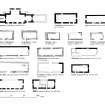Pricing Change
New pricing for orders of material from this site will come into place shortly. Charges for supply of digital images, digitisation on demand, prints and licensing will be altered.
Stoneywood, St Mary's Chapel And Graveyard
Burial Ground (Medieval), Chapel (Medieval), Holy Well (Medieval)
Site Name Stoneywood, St Mary's Chapel And Graveyard
Classification Burial Ground (Medieval), Chapel (Medieval), Holy Well (Medieval)
Alternative Name(s) St Mary's Of Stoneywood; Chapel Of Stoneywood
Canmore ID 19512
Site Number NJ81SE 10
NGR NJ 86627 11181
Datum OSGB36 - NGR
Permalink http://canmore.org.uk/site/19512
- Council Aberdeen, City Of
- Parish Newhills
- Former Region Grampian
- Former District City Of Aberdeen
- Former County Aberdeenshire
NJ81SE 10.00 86627 11181
(NJ 8663 1117) Chapel (NR) (Site of).
OS 25" map (1925)
For holy well within the churchyard, see NJ81SE 8.
The chapel at Newhills, dedicated to the Virgin Mary and later known as 'St Mary's of Stoneywood', was ordered to be completed in 1367 and was last mentioned in 1649. The foundations of the building, and a number of tombstones, stand in an enclosure near the Inverurie road at Chapel Farm.
J Cruickshank 1934
The low turf-covered foundations of the chapel are the only remains, and measure 10.6m x 6.0m x 0.4m high.
Visited by OS (EGC) 26 October 1961.
The remains of this medieval chapel are situated on the left bank of the Green Burn on a low river terrace within a stone-walled burial-ground. The NE corner of the chapel is visible as the footings of a boulder-faced wall 0.8m in thickness, and the rest of the ground-plan of the chapel is probably indicated by low, later walls, which provide overall measurements of 10.4m from ESE to WNW by 6m transversely.
The burial-ground contains gravestones dating from 1814 to 1884, and a holy well (NJ81SE 8).
Visited by RCAHMS (JRS), 10 April 2000.
(NJ 866 111) As part of Local Heritage Initiative Scotland, Northfield History Group, in conjunction with a number of other local groups, recorded and tidied up the area around Stoneywood Chapel, on the S side of the A96 Aberdeen to Inverness trunk road. The chapel was ordered to be completed in 1367, when King David II made a grant to his physician, Donald Bannerman, of the lands of Meikle and Little Clinterty, and of Auchriny.
The project also involved a small excavation to reveal further stones of the well (NJ81SE 8) within the chapel precinct. The finds are all 19th or 20th century. The well was sub-oval in shape, 2.44m long and 0.94m at its widest. The northern part of the well appeared to have been constructed first. This consisted of a C-shaped section of drystone walling. A water source was still entering the well, at 0.5m depth. At a later time another section was added to create the oval shape. This may have been in the 19th century.
Sponsor: Local Heritage Initiative.
A Cameron 2003.
Scheduled as 'St Mary's Chapel and graveyard... the remains of a 14th-century chapel and graveyard, visible as upstanding remains'.
Information from Historic Scotland, scheduling document dated 17 December 2010.
Earth Resistance Survey (1 June 2003)
At 1m probe separation, the 0.5m traverses should have approximately 1m optimum depth. The south wall of the Chapel appears to have substantial wall thickness below ground which may indicate that the low later walls are laid on an earlier foundation, but may be on a slightly tilted alignment. The NW corner also shows the vestiges of about 1.5m of buried wall. Inside the chapel, the low resistance running east from the large headstone is commensurate with disturbed soil from the burials. The roots of the large tree within the chapel makes secure analysis tenuous. The low at 7E12N may be the grave fill of the headstone there. At 15E4N there is a similar low adjacent to a large shrub, which raises the possibility of a grave. There is no indication of grave at the large headstone 18E3N. The significant low in the SW corner may indicate the seepage from the well running more SE than is indicated on the surface.
A large L shaped feature 15m x 12m of high resistance with a north pointing heel lies across the N/S slope of the graveyard. The linearity over such a substantial distance may indicate buried wall or rubble on lines running WSW/ENE and NNW/SSE. The lows lying along the boundary are probably moisture retention in the wall foundation ditch.










































